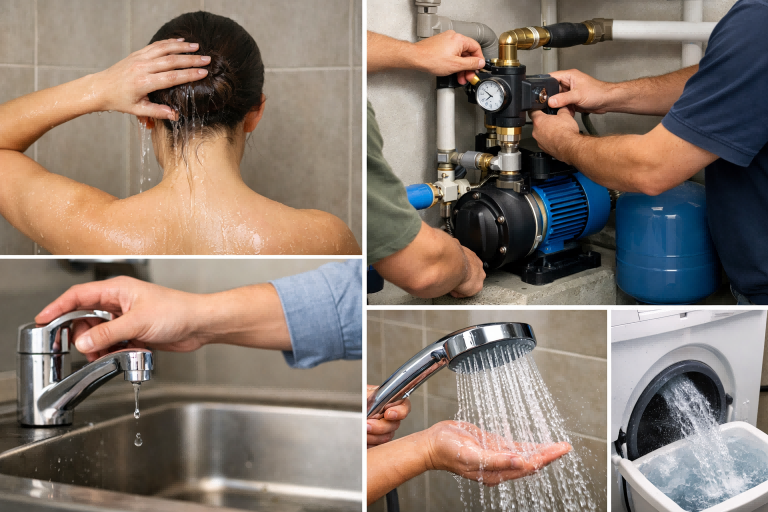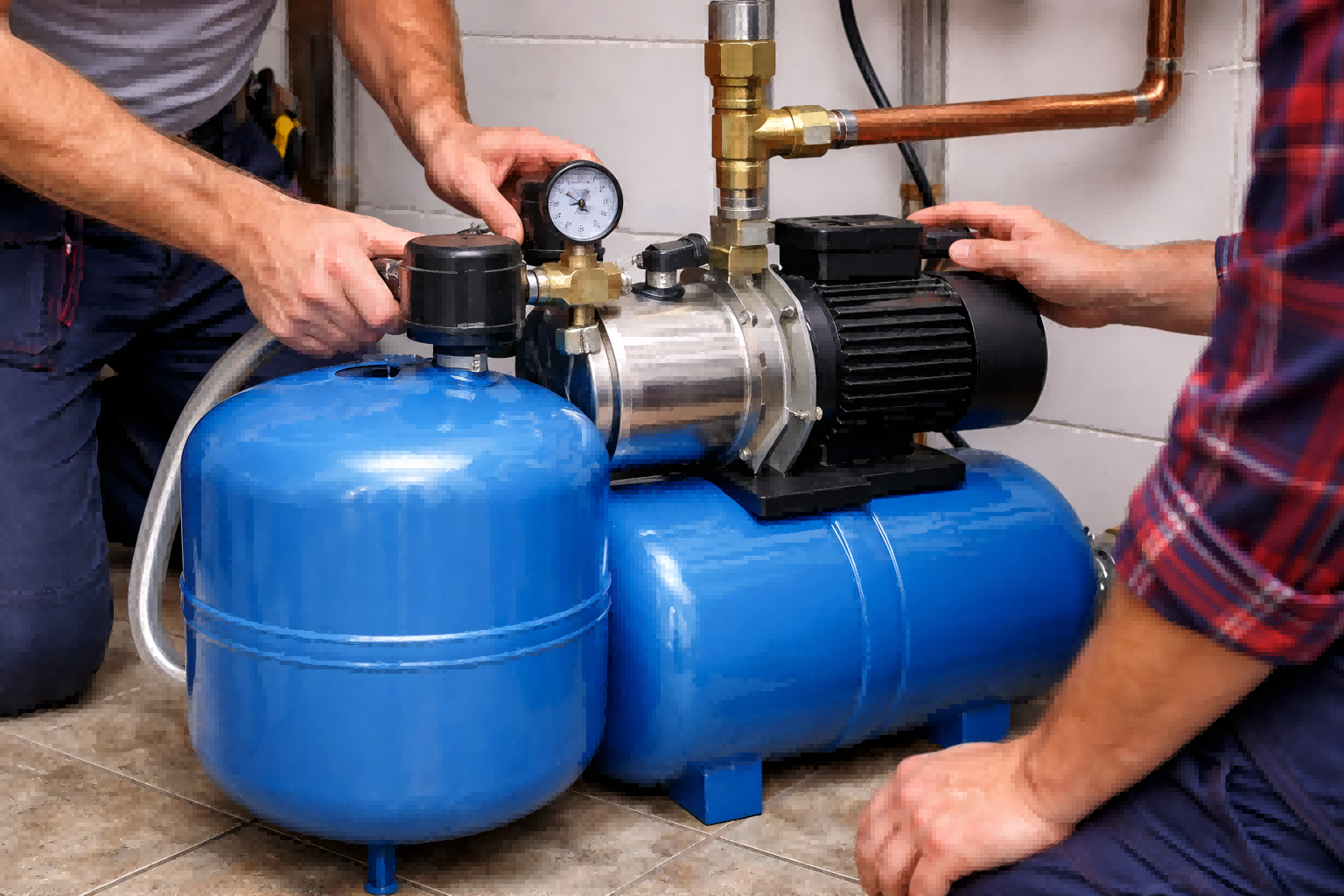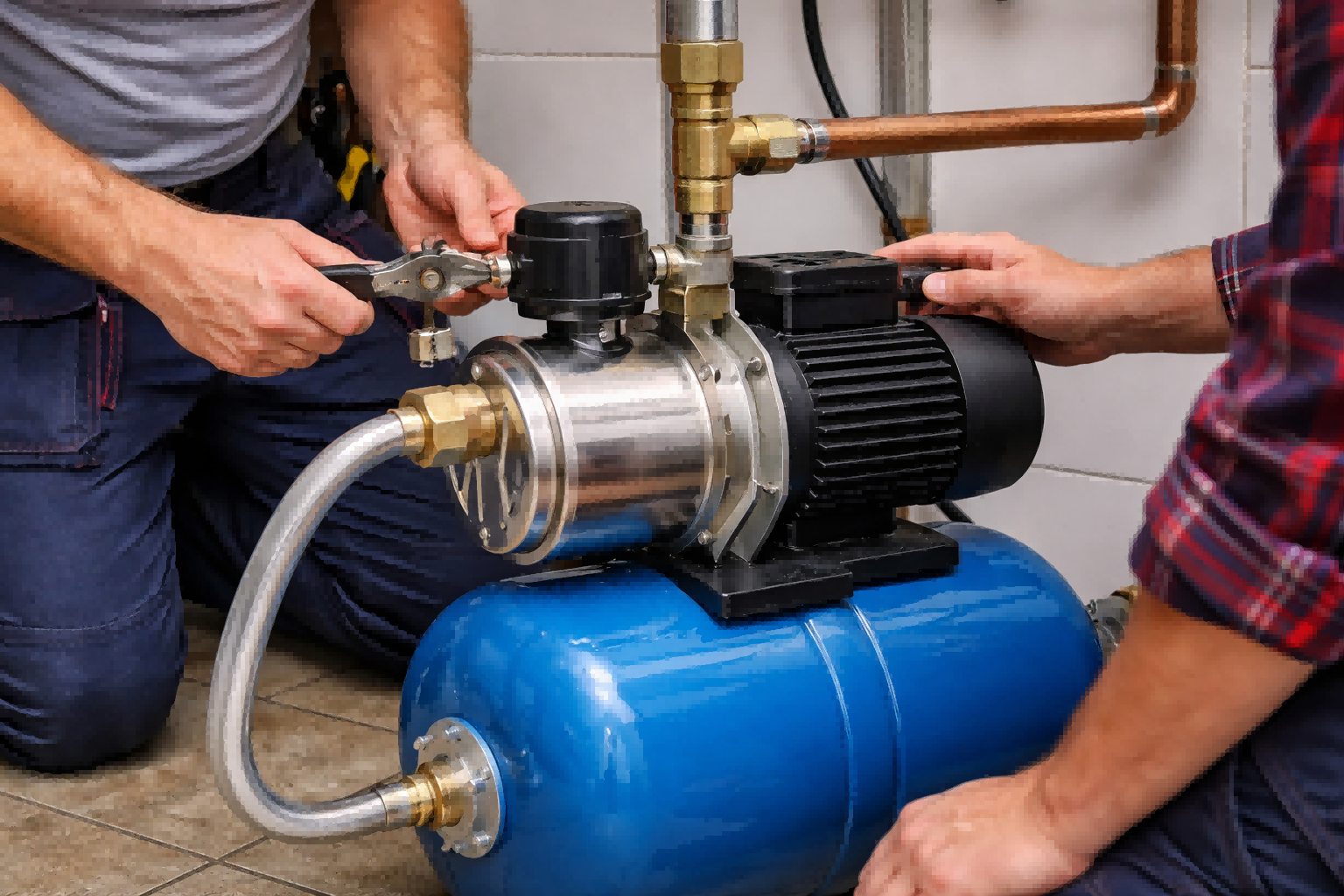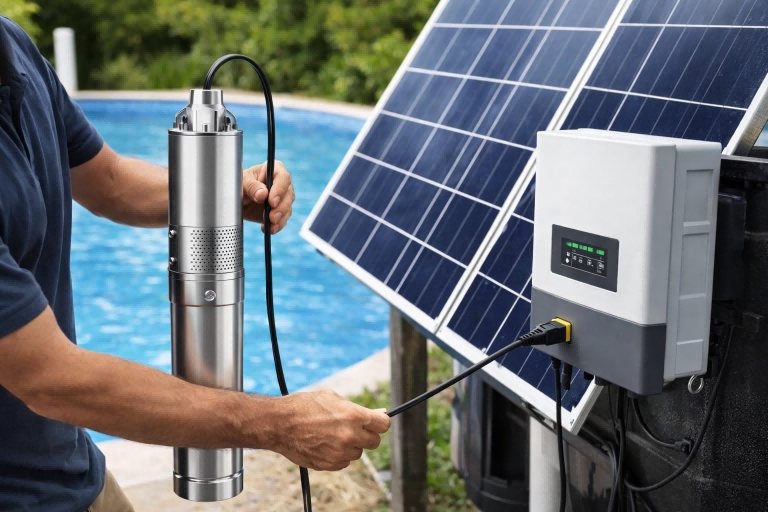Struggling with weak water flow in your building?
This frustration can disrupt daily activities.
The right pump technology provides a powerful, constant solution.
A booster pump increases pressure within an existing, flowing water system. A pressure pump is a broader term, often referring to any pump that moves water and creates pressure, including those drawing from a tank. In modern usage, the terms are frequently used interchangeably for boosting applications.
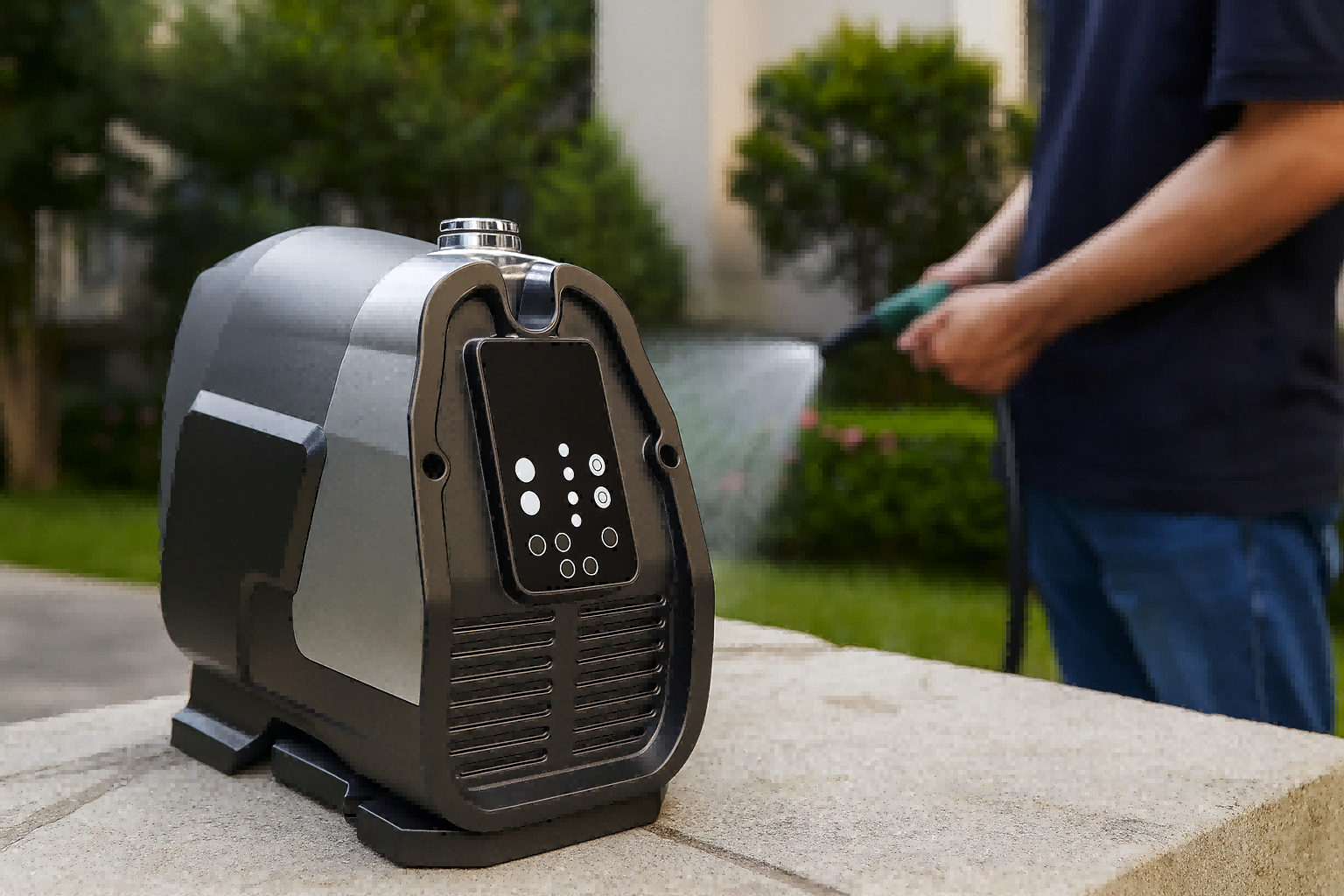
Understanding the terminology is the first step.
But the real value lies in the technology that drives today's advanced pumps.
Choosing the right system can transform your water supply, delivering consistent pressure while saving energy and reducing noise.
Let's explore the core components and intelligent features that define a high-performance booster pump and learn how they solve the challenges of modern water management.
What Core Technology Powers Modern Booster Pumps?
Tired of pumps that fluctuate in pressure and consume too much power?
This inefficiency leads to higher operational costs and an inconsistent water supply.
Advanced motor and drive technology solves this by delivering precise, constant pressure on demand.
The core of a modern booster pump is its Permanent Magnet Synchronous Motor (PMSM) paired with a Variable Frequency Drive (VFD). This combination allows the pump to adjust its speed in real-time, maintaining constant pressure while significantly cutting energy use and operational noise.
To truly grasp why this technology is superior, we need to look deeper into how these components work together.
It’s not just about one part; it's about the synergy between the motor, the drive, and the control system.
This integration delivers performance that older, fixed-speed pumps simply cannot match.
The Brains and Brawn: VFD and PMSM
A Variable Frequency Drive (VFD) is the intelligent controller of the pump system.
It acts like a dimmer switch for the motor, precisely regulating the amount of electricity it receives.
Instead of running at full power all the time, the VFD adjusts the motor's speed based on the real-time water demand.
This intelligent control is the key to energy efficiency and stable pressure.
The Permanent Magnet Synchronous Motor (PMSM) is the high-efficiency muscle.
Unlike traditional induction motors, PMSMs use powerful magnets, which results in less energy loss and a cooler, quieter operation.
When a VFD and PMSM work in tandem, they create a system with several key advantages.
Key Performance Advantages
This advanced pairing delivers measurable benefits that directly impact usability and cost-effectiveness.
- Constant Water Pressure: The system continuously monitors outflow and adjusts motor speed to keep the pressure exactly where you set it. This eliminates the annoying fluctuations common with older pumps. Users can typically customize the pressure setting within a wide range, from 20% to 95% of the pump's maximum head, to suit any application.
- Ultra-Quiet Operation: The smooth control of the VFD and the efficient design of the PMSM result in noise levels as low as 50 decibels. That's quieter than a library, making these pumps ideal for residential and noise-sensitive commercial environments.
- Soft Start and Stop: The VFD gradually ramps the motor's speed up and down. This "soft start" function prevents the sudden mechanical jolt and electrical surge of a traditional pump start-up. It drastically reduces wear on bearings and seals, extending the pump's life. It also mitigates water hammer, the damaging hydraulic shockwave that can stress pipes and fittings.
Below is a comparison of how this technology stacks up against traditional systems.
| Feature | VFD + PMSM System | Traditional Fixed-Speed Pump |
|---|---|---|
| Pressure Control | Constant, stable pressure | Fluctuating pressure, cycles on/off |
| Energy Usage | Matches demand, highly efficient | Always runs at 100% speed, high waste |
| Noise Level | Very quiet (≤50dB) | Loud and disruptive |
| Component Stress | Low, due to soft start/stop | High, due to abrupt on/off cycles |
| Lifespan | Longer due to reduced wear | Shorter due to mechanical stress |
This core technology is the foundation upon which all other features are built, providing a smarter, stronger, and more silent solution for water pressure needs.
Why Do Materials and Mechanical Design Matter?
Concerned that a new pump won't last?
Inferior materials and poor design lead to frequent failures, corrosion, and costly replacements.
Choosing a pump built with premium, durable components ensures long-term reliability and performance.
Excellence in mechanical engineering, from high-grade steel impellers to precision bearings, is crucial. These components directly impact a pump's efficiency, noise level, and operational lifespan. Quality materials prevent corrosion and withstand the constant stress of operation, guaranteeing a reliable investment.
A pump is more than just its motor.
The internal components handle the physical stress of moving water day in and day out.
The quality of these parts determines whether the system will perform reliably for years or fail prematurely.
Let's break down the critical mechanical elements that separate a top-tier pump from an average one.
The Heart of the Motor: Stator and Rotor
The stator and rotor are essential parts of the electric motor that drives the pump.
Their design and the materials used have a massive impact on performance and longevity.
A high-quality stator is built for efficiency and heat management.
Key features include:
- High-Grade Silicon Steel: Using superior steel like 600-grade reduces energy losses within the motor, making it more efficient.
- Low Temperature Rise: An effective design ensures the motor runs cooler (a temperature rise of ≤50K is excellent). Heat is the enemy of electronics and mechanical parts, so better cooling translates directly to a longer life.
- Class F Insulation: This high-temperature rating on the motor windings provides a safety margin, allowing the pump to operate reliably even under heavy loads or in hot environments.
The rotor often uses advanced ferrite magnets.
These magnets must be able to withstand high temperatures (up to 150°C) without losing their magnetic properties, which would degrade motor performance.
The Hydraulic Core: Impeller and Bearings
The impeller is the rotating component that actually moves the water.
Its material is critical for durability.
Top-tier pumps use AISI304 Stainless Steel for their impellers.
This material offers exceptional resistance to corrosion and abrasion, ensuring it won't degrade over time, even with varying water quality.
The bearings are the unsung heroes of any rotating machine.
They support the motor shaft and allow it to spin smoothly with minimal friction.
Using premium bearings from trusted manufacturers like NSK or C&U makes a significant difference.
Compared to standard bearings, these high-quality components offer:
- Higher Precision: Leads to better alignment and smoother operation.
- Quieter Performance: Reduced friction and tighter tolerances result in less noise.
- Longer Lifespan: Superior materials and manufacturing processes mean they can withstand more stress for a longer period.
These carefully selected materials and engineering choices are not just minor details; they are fundamental to creating a pump that is powerful, efficient, and built to last.
How Are Modern Pumps Protected From Failure?
Worried that environmental factors like moisture or power surges will damage your pump?
These common issues can destroy sensitive electronics, leading to unexpected and expensive breakdowns.
Advanced protection systems are essential for ensuring long-term operational reliability.
Modern pumps use a comprehensive suite of electronic and physical safeguards. The most critical is fully sealing the main controller (PCB) in a waterproof compound. This, combined with intelligent software monitoring, protects the unit from moisture, voltage fluctuations, overheating, and dry running.
A pump's intelligence and durability depend heavily on its electronic controller.
However, these electronics are often the most vulnerable part of the system, especially in the damp and demanding environments where pumps operate.
Leading manufacturers have developed robust solutions to shield this electronic brain from harm.
Let's examine how these multi-layered protection strategies work.
The Ultimate Electronic Shield: PCB Potting
The single most effective feature for ensuring long-term electronic reliability is potting the Printed Circuit Board (PCB).
Potting involves completely encasing the entire controller board and its components in a solid, waterproof, and shock-resistant resin.
This creates an impenetrable barrier against environmental threats.
This technique provides several critical advantages:
- Total Waterproofing: It creates a 100% waterproof and dustproof seal, earning the electronics an IP67 rating. This makes the controller impervious to humidity, condensation, and even temporary submersion. It can prevent over 95% of failures caused by moisture.
- Vibration and Shock Resistance: The solid compound holds every component firmly in place, protecting delicate solder joints from damage caused by vibration during operation.
- Extended Lifespan: By isolating the sensitive electronics from the harsh operating environment, this feature can extend the controller's life by an estimated 3 to 5 years.
Smart Software: A Comprehensive Safety Net
Beyond physical protection, an intelligent pump uses its software to actively monitor its own health and operating conditions.
A comprehensive protection system, sometimes called a "14-Shield" system, guards against a wide array of potential faults.
This system is divided into different categories of protection.
Electrical and Thermal Protections
These functions protect the pump from poor power quality and heat-related issues.
| Protection Type | Function |
|---|---|
| Voltage Protection | Shuts down the pump if input voltage is too high or low. |
| Overcurrent Protection | Prevents damage from electrical surges. |
| Phase Loss Protection | Safeguards the motor if one phase of a three-phase supply is lost. |
| Stall Protection | Stops the motor if it becomes jammed to prevent burnout. |
| Overheating Protection | Monitors both the driver board and water temperature to prevent damage. |
System and Hydraulic Protections
These safeguards protect the pump from problems related to water supply and the plumbing system.
A key feature is Dry Run Protection.
If the pump detects a water shortage, it doesn't just shut off.
It initiates an intelligent, multi-stage recovery algorithm.
It will try to self-prime, then enter a sleep mode and periodically re-check for water.
This process prevents the pump from damaging itself while automatically resuming operation once water is restored.
Other protections include antifreeze functions for cold climates and pipeline leak warnings, which can alert you to costly problems in your plumbing.
This combination of physical hardening and smart software ensures the pump can survive and thrive in real-world conditions, providing reliable service for years.
How Can You Control and Monitor an Advanced Pump?
Find complex controls and lack of information on traditional pumps frustrating?
Without clear feedback, it's impossible to know if your system is running efficiently or if a problem is developing.
Modern pumps feature intuitive interfaces and real-time data monitoring for complete control.
An advanced booster pump provides a user-friendly interface with simple button controls and clear LED indicators. It allows for easy pressure adjustment and displays critical live data like power usage, motor speed, and system temperature, giving users full insight into the pump's performance.
A powerful and intelligent pump is only useful if it's easy to operate.
Complexity should be engineered into the background, while the user experience remains simple and intuitive.
Top-tier systems are designed to provide both straightforward control for day-to-day adjustments and deep data access for diagnostics and performance monitoring.
Let's explore the features that make these pumps so user-friendly.
Simple Controls for Everyday Use
Despite the sophisticated technology inside, operating a modern pump is remarkably simple.
The user interface is typically designed with just a few buttons for all primary functions.
- POWER Button: A short press turns the pump on or off. A long press (e.g., 3 seconds) can be used to reset the system to factory settings.
- UP / DOWN Buttons: Short presses of these buttons allow you to instantly increase or decrease the target water pressure, tailoring it to your exact needs.
This streamlined approach removes guesswork and makes it easy for anyone to manage their water system.
At-a-Glance Status with LED Indicators
Clear visual feedback is essential for quickly understanding the pump's status.
A well-designed interface uses a series of distinct LED indicators to communicate what the pump is doing.
You can instantly see if the pump is:
- Running in constant pressure mode.
- Warning of a potential pipeline leak.
- Indicating a fault with the input voltage.
- In a water shortage (dry run) state.
- Operating at a specific power level (often shown with a bar graph).
This immediate feedback allows for quick diagnostics without needing to navigate complex menus.
Deep Dive into Real-Time Data
For users who want more detailed information, advanced systems offer a live data monitoring mode.
By pressing and holding a specific button, you can cycle the display through a series of critical operating parameters.
This provides an unparalleled look into the pump's real-time performance.
| Display Code | Parameter | What It Tells You |
|---|---|---|
A.xx |
Water Temperature | Monitors the temperature of the water passing through the pump. |
P.xxx |
Real-time Power | Shows exactly how much power (in watts) the pump is consuming at that moment. |
xxxx |
Motor Speed | Displays the motor's current rotational speed in RPM. |
U.xxx |
Input Voltage | Shows the live voltage from your electrical supply. |
t.xx |
PCB Temperature | Monitors the temperature of the main electronic controller board. |
This level of transparency empowers users to verify efficiency, diagnose potential issues with their electrical or water supply, and have complete confidence in their system's operation.
Optional features like WiFi connectivity take this even further, allowing for remote monitoring and adjustments from a smartphone app, putting total control in the palm of your hand.
Conclusion
Ultimately, the best pump provides constant pressure reliably and efficiently.
Advanced technology, from VFD motors to comprehensive protection systems, ensures this performance is delivered quietly and with a long operational lifespan.
FAQs
1. What is the main purpose of a booster pump?
A booster pump's primary job is to increase the pressure of water in an existing plumbing system. It is used when the municipal supply or well pressure is too low.
2. Can a booster pump increase water flow?
Yes, by increasing the pressure, a booster pump also increases the flow rate (GPM) at the fixtures. Higher pressure pushes more water through the pipes in the same amount of time.
3. When would you use a pressure pump?
You would use a pressure pump to draw water from a static source, like a storage tank or a shallow well, and create pressure to supply a home or irrigation system.
4. How do I know if I need a booster pump?
If you experience weak showers, slow-filling appliances, or a significant drop in pressure when multiple taps are open, you likely need a booster pump to improve your water supply.
5. Are booster pumps noisy?
Older, traditional booster pumps can be quite noisy. However, modern pumps with VFD and PMSM technology are designed for ultra-quiet operation, often running quieter than a refrigerator.
6. Do I need a pressure tank with a VFD booster pump?
While not always required, a small pressure tank is highly recommended. It reduces pump cycling for very small water uses and helps absorb hydraulic shock (water hammer), extending the pump's life.
7. What PSI should my booster pump be?
Most residential water systems operate best between 40 and 60 PSI. An adjustable VFD booster pump allows you to set the precise pressure you desire for optimal comfort and performance.
8. What is the difference between a booster pump and a circulator pump?
A booster pump increases water pressure for delivery to taps and fixtures. A circulator pump is designed to move water within a closed loop, such as in a hot water heating system.


